Oatmeal is one of the best cholesterol-lowering breakfast foods, thanks largely to the health benefits oatmeal has to offer. In fact, consuming a hearty bowl of oatmeal can literally reduce the “bad” LDL cholesterol and improve other markers of cardiovascular disease (CVD) risk, making it a cholesterol-lowering superstar.
Under the sea of good for you nutrients this dish provides – including B vitamins, iron, and magnesium – oats contain a unique soluble fiber called beta-glucans. This soluble fiber has been linked to improving the removal of bile acids and cholesterol from the body, resulting in lower cholesterol levels.
CONNECTED: The Best Breakfast Foods That You Should Eat When You Have High Cholesterol, Say Dietitians
So strong is the evidence of oat beta-glucans’ cholesterol benefits that the US Food and Drug Administration (FDA) approves the use of a heart health claim when oats are used in a food. In particular, this health-related claim underlines how the daily consumption of at least 3 grams of beta-glucans can have cholesterol-lowering properties.
Bottom line? Oats are a powerhouse when it comes to supporting healthy cholesterol levels. And to make things even better You can add ingredients to your cozy bowl of oatmeal that complement the cholesterol-lowering benefits of oats and make this dish even healthier.
From walnuts to blueberries to interesting spices like turmeric, the oatmeal add-in options are endless. Among the huge variety of ingredients, here are 10 delicious combinations of ingredients that will help you lower your cholesterol levels. Read on, and to learn more about how to eat healthily, check out these safe ways to lower your cholesterol, say nutritionists.
Shutterstock
Topping your oatmeal with walnuts and raisins may sound pretty easy, but this classic oat topping combo has something when it comes to supporting healthy cholesterol levels.
In a recent study examining healthy elderly people, those who included a daily dose of walnuts in their diet (about 14-24 halves) experienced a decrease of about 4.3 milligrams per deciliter of LDL (“bad “) Cholesterol. Those diagnosed with high cholesterol benefited more from the walnuts than those who had healthy cholesterol levels at the start of the study.
And raisins, a natural source of fiber and potassium with no added sugar, are a natural choice when a little sweetness is needed along with cholesterol-lowering nutrients.
Topping your oatmeal with this classic duo may not be the most exciting of choices, but it’s effective and super easy to do. And it can be the trick your body needs to keep your cholesterol levels under control.
CONNECTED: Sign up for our newsletter to receive recipes and food news in your inbox daily!
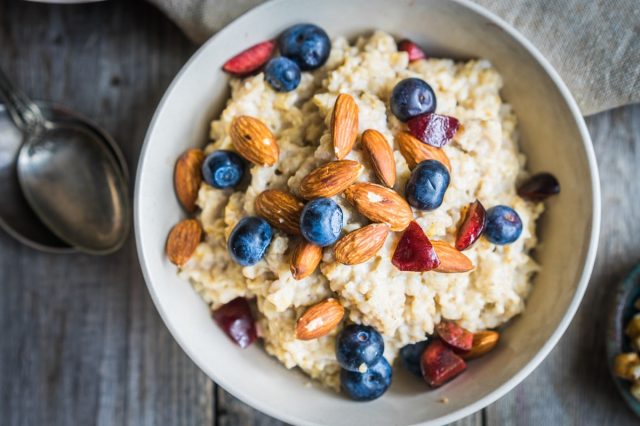 Shutterstock / Alena Haurylik
Shutterstock / Alena Haurylik
When it comes to your heart health, topping your oatmeal with fresh or frozen blueberries and a dash of pure maple syrup can be topped off.
Blueberries add a natural sweetness to your oats along with natural fiber, vitamins, minerals, and polyphenols that have been shown to help keep your heart health in tip-top shape. And according to the results of a study published in the American Journal of Clinical Nutrition, people with metabolic syndrome who consumed the equivalent of a cup of fresh blueberries every day had positive results for heart health, including increased HDL cholesterol levels.
While people who are focused on lowering their cholesterol shouldn’t include too many added sugars in their diet, a small addition of pure maple syrup along with some natural antioxidants can add that much-needed flavor. In particular, a unique molecule called Quebec, found in 100% pure Canadian maple syrup, has anti-inflammatory properties. Since higher levels of an inflammatory marker are associated with lower HDL (“good”) cholesterol, finding ways to treat inflammation naturally, such as leaving pure Canadian maple syrup in place of refined sugar, may help find ways to treat inflammation naturally.
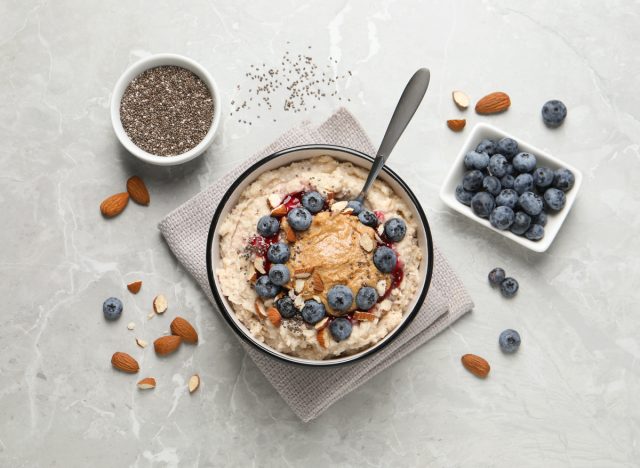 Shutterstock
Shutterstock
This popular combination of peanut butter and jelly doesn’t have to be reserved solely for sandwiches. A tablespoon of natural peanut butter (chunky or creamy also works) and fresh or frozen berries give you that nostalgic taste along with some heart health benefits. Using berries instead of added sugar jellies can help provide your body with natural antioxidants, vitamins, and minerals that can support healthy cholesterol levels. And peanut butter, a cholesterol-free, plant-based protein source has been shown to lower total cholesterol and triacylglycerol levels in certain populations, making it an ideal addition to your breakfast dish.
 Shutterstock
Shutterstock
Just because you’re a chocolate lover doesn’t mean you have to forego your beloved taste in trying to support healthy cholesterol levels. In fact, according to a meta-analysis published in the European Journal of Clinical Nutrition, consuming cocoa products like dark chocolate can help lower LDL and total cholesterol levels, good for you oatmeal.
Combining fresh or frozen strawberries with chocolate is a natural choice, as strawberries dipped in chocolate are a popular treat that virtually everyone with taste buds loves. Plus, the antioxidants, fiber, and phytochemicals in strawberries have been shown to lower total cholesterol.
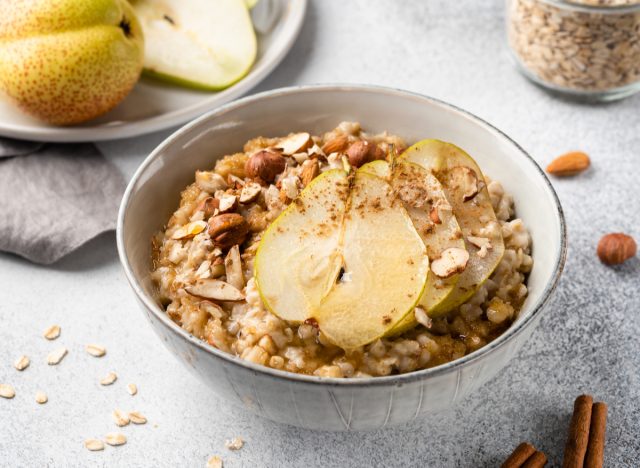 Shutterstock
Shutterstock
Cinnamon is a popular spice that goes into many oatmeal recipes. But adding this aroma can offer some cholesterol-lowering benefits as well. While the amount of cinnamon you add to your oatmeal may not be enough to have a real impact on your cholesterol levels, adding some cinnamon to your morning oats can give you a head start on your daily quota throughout the day to reach.
And chopped pears (with the skin still tightened) braised in water and cinnamon can be a heart-healthy addition that adds a cozy touch to many recipes, including oatmeal, as consuming fresh pears daily will improve cardiometabolic health in middle-aged people and older adults with metabolic syndrome.
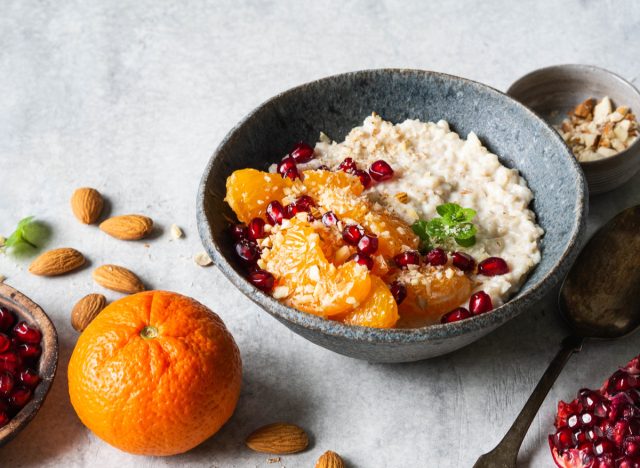
A glass of 100% orange juice is a cholesterol-lowering powerhouse, as data shows that drinking 750 milliliters (or just over a cup) of this natural juice every day for 8 weeks can lower LDL cholesterol levels in both normal and overweight people.
Instead of drinking your OJ, why not eat it? Using 100% orange juice in your oatmeal recipes will add a nice citrus flavor to your dish along with a heart-healthy bonus. Just boil 1 cup of oatmeal with 1 cup of OJ and 1½ cup of water. Top your oats with pomegranate seeds, sliced almonds, and a pinch of cinnamon for a breakfast that’s anything but ordinary.
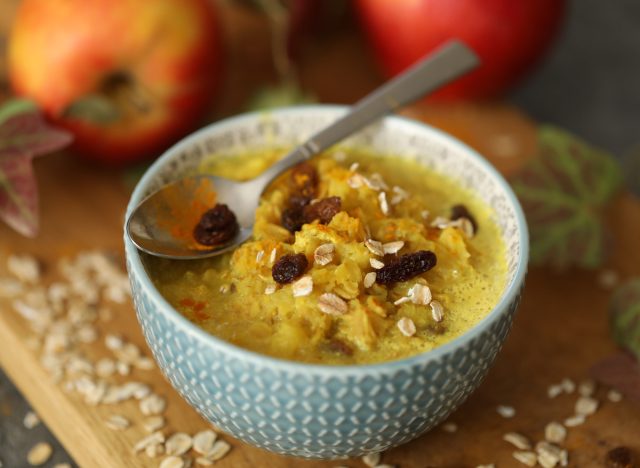 Shutterstock
Shutterstock
If you haven’t gotten on the turmeric train yet, this oatmeal recipe idea might be for you. According to the results of a meta-analysis of randomized control studies published in the Nutrition Journal, turmeric supplementation is linked to lowering LDL and triglyceride levels in people at risk for cardiovascular disease. While you may not be able to smuggle a clinical dose of turmeric into your bowl of oatmeal, ingesting this spice is certainly not going to harm your heart health.
To make Turmeric Oats (AKA Golden Oats), simply add 1 teaspoon of ground turmeric to your already made oatmeal and enjoy!
 Shutterstock
Shutterstock
The secret ingredient for oatmeal that, along with cholesterol-lowering benefits, gives you some staying power is pureed chickpeas. In fact, after evaluating 26 randomized controlled trials that included the consumption of legumes (including chickpeas), the results showed that inclusion of these foods can significantly lower LDL cholesterol levels.
To make a powerful oatmeal, simply add ¼ cup of washed, rinsed, and mashed chickpeas to your oatmeal and top it with the toppings that are right for you. Not only are you getting heart health benefits, but you also get a boost in fiber and protein to keep you happy until lunch.
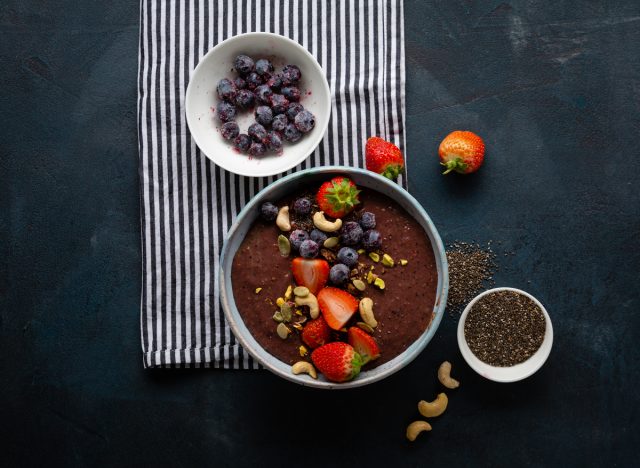 Shutterstock
Shutterstock
We all know (and love) a classic acai bowl on a warm summer day. But when the weather turns bad, the last thing we want is an icy and fruity bowl to start our morning with.
You can still enjoy the tastes and benefits of acai while preparing yourself a cozy bowl of oatmeal. Since acai has beneficial effects on plasma HDL metabolism, it would be a shame to remove this berry from your diet during the coldest months of the year.
When you add some acai powder or thawed acai puree to your oatmeal, you get a gorgeous bowl of goodness loaded with antioxidants. Top with fresh fruit and a dollop of natural nut butter for an acai-bowl-like breakfast that stands a little more on the ribs for the winter time.
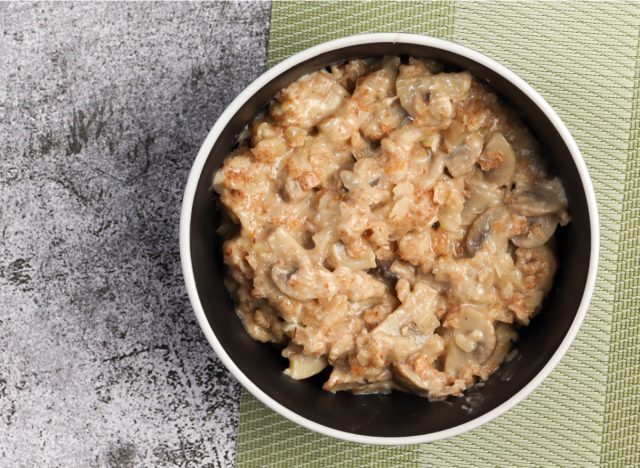 Shutterstock
Shutterstock
Oatmeal doesn’t just have to be for breakfast. Hearty oatmeal can be very filling and help you incorporate important nutrients into your diet, especially if you’re not a breakfast eater.
Savory mushroom oatmeal is just as nutritious and delicious. And thanks to the addition of mushrooms, you get a double dose of these cholesterol-lowering beta-glucans, as mushrooms naturally contain the same fiber as oats.
To make hearty mushroom oatmeal, cook your oats in chicken broth instead of water and stir in sautéed mushrooms, onions, garlic, and spinach. Cover the dish with some fresh parmesan and enjoy your simple and vegetable-rich dinner!
Read this next:
